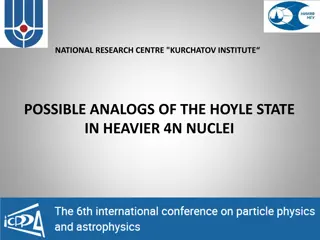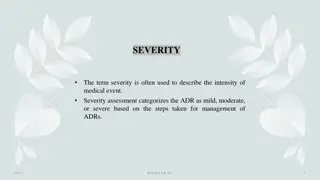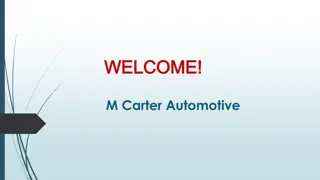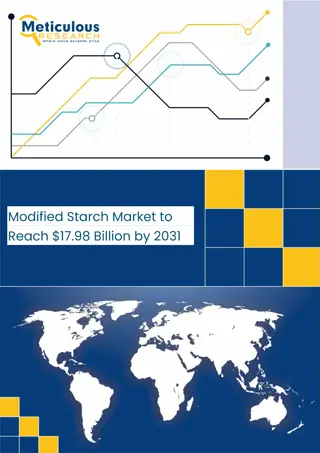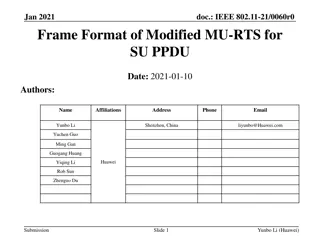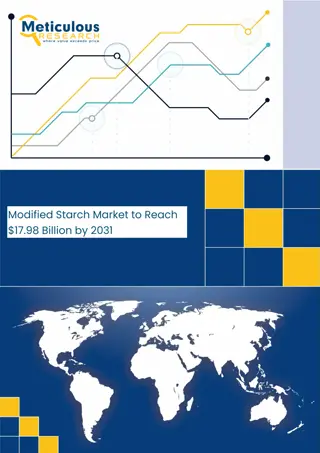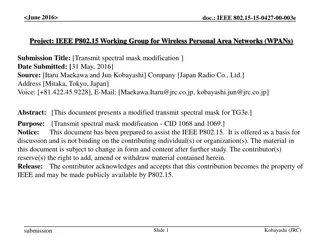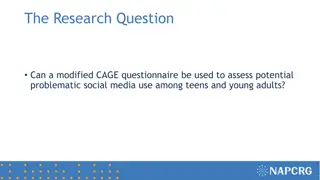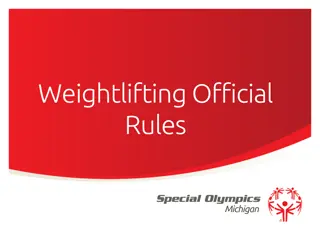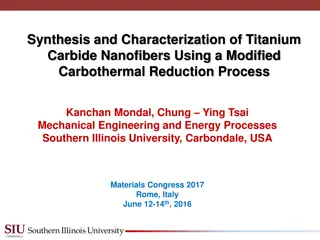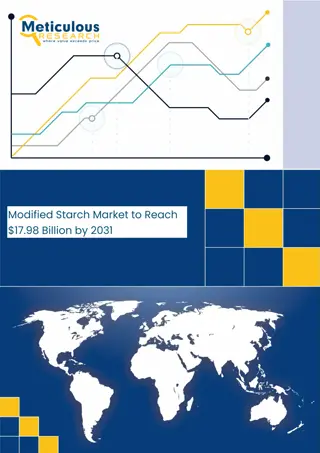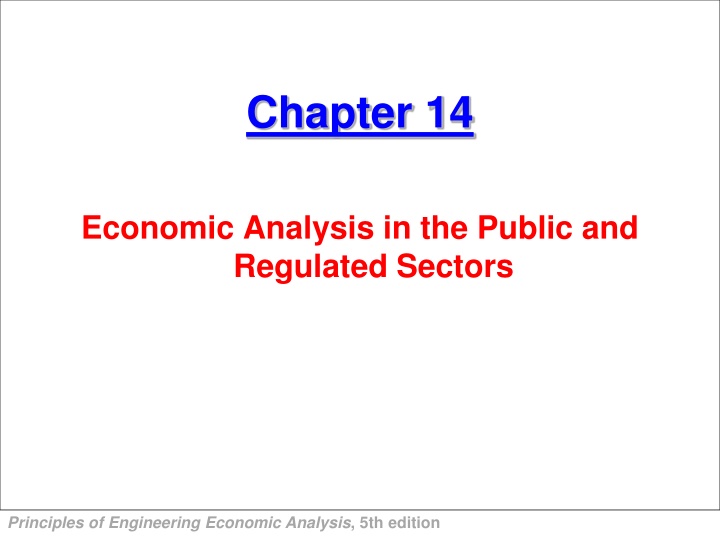
Economic Analysis in Public and Regulated Sectors
Explore the principles of economic analysis in public projects, including benefit-cost analysis and cost effectiveness. Learn about Build-Operate-Transfer model, BOT characteristics, public project evaluation objectives, and guidelines in public sector evaluation. Benefit from insights on evaluating projects for the greater good of the public, assessing costs and benefits over time, and using analysis to set regulatory priorities efficiently.
Uploaded on | 0 Views
Download Presentation

Please find below an Image/Link to download the presentation.
The content on the website is provided AS IS for your information and personal use only. It may not be sold, licensed, or shared on other websites without obtaining consent from the author. If you encounter any issues during the download, it is possible that the publisher has removed the file from their server.
You are allowed to download the files provided on this website for personal or commercial use, subject to the condition that they are used lawfully. All files are the property of their respective owners.
The content on the website is provided AS IS for your information and personal use only. It may not be sold, licensed, or shared on other websites without obtaining consent from the author.
E N D
Presentation Transcript
Chapter 14 Economic Analysis in the Public and Regulated Sectors Principles of Engineering Economic Analysis, 5th edition
The Nature of Public Projects Projects should provide benefits for the greater good of the public that exceed the costs of providing those benefits. The most frequently used method in evaluating government (local, state, or federal) projects is benefit-cost analysis. Next most frequent is cost effectiveness analysis. Principles of Engineering Economic Analysis, 5th edition
Build-Operate-Transfer Build-Operate-Transfer expands the private sector role, allowing public agencies to tap into private sector technical, management and financial resources. This achieves (1)greater cost and schedule certainty, (2) supplements to in-house staff, (3) innovative technology applications, (4) specialized expertise, and (5) access to private capital. Principles of Engineering Economic Analysis, 5th edition
BOT characteristics include: 1. Responsibility: design, construct, and maintain 2. Life-cycle costing: more money on maintaining 3. Procurement process (competitive bid): single price 4. Standard specifications: great care of the government Principles of Engineering Economic Analysis, 5th edition
Objectives in Public Project Evaluation Flood Control Act on June 22,1936: the Federal Government should improve or participate if the benefits to whomsoever they may accrue are in excess of the estimated costs . River and Harbor Act of 1902: required a board of engineers to report on the amount of commerce benefited and the cost. Prest and Turvey on benefit-cost analysis: a practical way of assessing the desirability of projects where it is important to take a long view and a wide view; it implies enumeration and evaluation of all relevant costs and benefits. (positive VS negative impacts) Principles of Engineering Economic Analysis, 5th edition
Benefit-cost analyses take a long view (over time) and a wide view (individuals, groups and things) and evaluate monetized benefits, disbenefits, and costs. Principles of Engineering Economic Analysis, 5th edition
Guidelines in Public Sector Evaluation (from Arrow, et al) 1. B/C analysis is useful to compare favorable and unfavorable effects of a policy 2. B/C analysis is useful in achieving a desired goal at the lowest possible cost 3. Agencies should use B/C analysis to set regulatory priorities 4. B/C analysis should be required for all major decisions 5. When costs far exceed benefits in an accepted decision, the other factors (non-economic benefits e.g. equity) should be stated or weight differently the factors 6. B/C analysis should be done on major health, safety, and environmental regulations to inform legislators Principles of Engineering Economic Analysis, 5th edition
Example 14.1 Costs and benefits for a public sector investment program are shown on the next slide. The planning horizon is 10 years and TVOM is i = 7%. Principles of Engineering Economic Analysis, 5th edition
Note that the PW of benefits is $1,424,102, and the PW of costs is $1,063,987,the net PW of benefits minus costs is $360,115 and the B/C ratio =1.33. So, the program is desirable when considered alone. Principles of Engineering Economic Analysis, 5th edition
Systematic Economic Analysis Technique 1. Identify the (public-sector) investment alternatives 2. Define the planning horizon (for the benefit-cost study) 3. Specify the discount rate 4. Estimate the (benefit and cost profiles in monetary terms) cash flows 5. Compare the alternatives (using a measure of worth related to benefits and costs) 6. Perform supplementary analyses 7. Select the preferred (alternative) investment Principles of Engineering Economic Analysis, 5th edition
Benefit-Cost and Cost-Effectiveness Calculations Benefit-cost analysis typically uses: - B/C benefit-cost ratio - B-Cbenefits minus costs Both B and C are expressed in monetary units as PW or AW (or even FW) where an appropriate discount rate i has been used to calculate PW or AW. Principles of Engineering Economic Analysis, 5th edition
B/C Formula n t + = n B (1 i) t = (14.1) t 1 B/C(i) t + = C (1 i) t Where t = end of year, n = planning horizon, i = discount rate, Bt is benefits in t, and Ct is costs in t, where both Btand Ct are expressed in monetary units. t 0 >1 then it s desirable Principles of Engineering Economic Analysis, 5th edition
n n t t = + + = = B C(i) B (1 i) C (1 i) 1 (14.2) t t t t 0 >0 then it s desirable Where t = end of year, n = planning horizon, i = discount rate, Bt is benefits in t, and Ct is costs in t, where both Btand Ct are expressed in monetary units. Principles of Engineering Economic Analysis, 5th edition
Comparing Two Alternatives When two project alternatives are being compared using a B/C ratio, the analysis should be done on an incrementalbasis. Let the alternative with the lower present worth of costs be Alternative 1 and let the other be Alternative 2. Then , the incremental benefits of the second alternative over the first, B2-1(i), are divided by the incremental costs of the second over the first, C2-1(i). Principles of Engineering Economic Analysis, 5th edition
Incremental B/C Ratio n = n + t (B B )(1 i) 2t 1t (i) B = = (i) t 1 2 1 B/C (14.3) 2 1 (i) C = t + t (C C )(1 i) 2 1 2t 1t 0 Incremental B/C analysis is like incremental rate of return analysis. Here, you prefer alternative 2 over 1 as long as the B/C > 1. Then, compare alternative 3 to the winner of 1 and 2, and so on Do not just select the alternative with the highest overall B/C ratio (similar to IEE and ERR) Principles of Engineering Economic Analysis, 5th edition
Comparing Two Alternatives When two project alternatives are being compared using B-C, no special incremental procedure is necessary Just select the alternative that has the highest value of B- C Principles of Engineering Economic Analysis, 5th edition
Cost-Effectiveness Analysis Use cost-effectiveness analysis whenever each alternative has the same annual benefits or effects. Simply minimize the PW or AW of costs n = t = C i C i ( ) min ( ) j preferred j jt , (14.5) 0 Or, use C-E analysis when alternatives have the same costs. Maximize the PW or AW of benefits n = t = B i B i ( ) max ( ) (14.6) j preferred j jt , 1 Principles of Engineering Economic Analysis, 5th edition
Example 14.2 Three highway alternatives, A, B, and C Benefits are assumed to be all equal, so use Cost- Effectiveness analysis For each alternative, AWtotal= AWfirst/resurfacing + AWmaintenance See next slide for data and calculations Route A wins with lowest cost! Principles of Engineering Economic Analysis, 5th edition
2,000,000*26*(P/F,8,10)(A/P,8,30)+2,000,000*26*(P/F,8,20)(A/P,8,30)2,000,000*26*(P/F,8,10)(A/P,8,30)+2,000,000*26*(P/F,8,20)(A/P,8,30) 2,000,000*26*(A/P,8,30) 10,000*26 Sum of the annual worth Route A is the Lowest cost Principles of Engineering Economic Analysis, 5th edition
Example 14.3 Same road project as Example 2, except considering different benefits for A, B, and C Different numbers of vehicle types considered Cost of operation is considered for each type Cost of time spent driving, by vehicle, is considered Cost of accidents on each route is also considered Relevant government and public costs are given on the next slide, and the incremental B/C analysis follows two slides from here. Note that benefits here are expressed as cost savings Principles of Engineering Economic Analysis, 5th edition
Relevant government and public costs plus other input data. Principles of Engineering Economic Analysis, 5th edition
[350*(1/45)*25+250*(1/35)*25+80*0.30+(80*(1/45)*10+3320*0.25*(1/45)*10)*26*365[350*(1/45)*25+250*(1/35)*25+80*0.30+(80*(1/45)*10+3320*0.25*(1/45)*10)*26*365 [350*0.7+250*1.1+80*0.30+(830+2490)*0.6]*26*365 105*18,000 Principles of Engineering Economic Analysis, 5th edition
Example 14.3, concluded Note that government costs are given as: A: $8,009,533; B: $8,775,501; C: $10,162,134 So, incremental costs B to A = $765,968 and incremental costs C to B = $1,386,633 Note that costs to public are: A: $39,292,350; B: $31,833,888; C: $29,305,441 So, incremental Benefit B to A = $7,458,462 and incremental Benefit C to B = $2,528,447 B/C B to A = $7,458,462/$765,968 = 9.74 B wins B/C C to B = $2, 528, 447/$1,386,633 = 1.82 C wins Principles of Engineering Economic Analysis, 5th edition
Example 14.4 The difference in incremental benefits and costs may be used for Example 14.3 (B-C)B-A = BB-A - CB-A = $7,458,462 - $765,968 = $6,692,494/year (B-C)C-B = BC-B CC-B = = $2,528,447 1,386,633 = $1,141,814/year C wins overall same as in Example 14.3 So, B is preferred to A And, C is preferred to B Principles of Engineering Economic Analysis, 5th edition
Notes on Ex. 14.2, 14.3, and 14.4 Example 14.2 used Cost Effectiveness Analysis, comparing government costs only, since benefits were assumed equal for each of routes A, B, and C Examples 14.3 and 14.4 used Benefit-Cost analysis since benefits were assumed different for each of routes A, B, and C The incremental B/C ratio was used in Example 14.3, and incremental B-C analysis was used in Example 14.4 Incremental benefits and incremental costs were evaluated using annual worth. Of course, the present worth of all costs would have been perfectly fine to use. Principles of Engineering Economic Analysis, 5th edition
B/C analysis is useful for evaluating one project. Incremental B/ C analysis is required when comparing more than one alternative. B-C analysis is useful for one or many alternatives. More often than not, the benefit-cost ratio B/C (or incremental B/C ratio) is used. This is unfortunate because, just as in rate of return analyses in the private sector, the benefit-cost ratio B/C is easy to misuse and misinterpret Also, the B/C ratio is very sensitive to the classification of problem elements as "benefits" or "costs." B-C is not. Principles of Engineering Economic Analysis, 5th edition
A city is considering building a new Public Library to serve its citizens. Three alternatives have been identified with the following data: Government Alternative A Alternative B Alternative C Initial Cost (SR) 6,000,000 4,000,000 9,000,000 Annual Maintenance Cost (SR/year) 180,000 210,000 260,000 Public Benefits (SR/year) Dis-benefits(Cost) (SR/year) Alternative A 1,000,000 150,000 Alternative B 900,000 400,000 Alternative C 1,500,000 500,000 Using 8% interest rate, 15-year study period, a salvage value of 50% of the initial cost, and B/C ratio, determine which alternative should be selected. Principles of Engineering Economic Analysis, 5th edition
AW analysis Costs to the city: Cost (A) = 6,000,000 (A/P 8, 15) + 180,000 - 6,000,000 X 0.5 (A/F 8, 15) = SR 770,490/year Cost (B) = 4,000,000 (A/P 8, 15) + 210,000 - 4,000,000 X 0.5 (A/F 8, 15) = SR 603,660/year Cost (C) = 9,000,000 (A/P 8, 15) + 260,000 - 9,000,000 X 0.5 (A/F 8, 15) = SR 1,145,735/year Benefit to the users: Benefit (A) = 1,000,000 - 150,000 = SR 850,000/year Benefit (B) = 900,000 - 400,000 = SR 500,000/year Benefit (C) = 1,500,000 - 500,000 = SR 1,000,000/year Principles of Engineering Economic Analysis, 5th edition
PW analysis Costs to the city: Cost (A) = 6,000,000 + 180,000 (P/A 8, 15) - 6,000,000 X 0.5 (P/F 8, 15) = SR 6,594,986.4 Cost (B) = 4,000,000 + 210,000 (P/A 8, 15) - 4,000,000 X 0.5 (P/F 8, 15) = SR 5,167,010.8 Cost (C) = 9,000,000 + 260,000 (P/A 8, 15) - 9,000,000 X 0.5 (P/F 8, 15) = SR 9,806,884.8 Benefit to the users: Benefit (A) = (1,000,000 - 150,000) (P/A 8, 15) = SR 7,275,550 Benefit (B) = (900,000 - 400,000) (P/A 8, 15) = SR 4,279,740 Benefit (C) = (1,500,000 - 500,000) (P/A 8, 15) = SR 8,559,480 Principles of Engineering Economic Analysis, 5th edition
Pit Stop #14 Same Thing; Different Look 1. True or False: Benefit-cost analysis is primarily used by regulated utilities. False. It is used in the public sector. Revenue Requirements analysis is used by regulated utilities. True or False: Build-Operate-Transfer (BOT) makes use of a public-private partnership. True, in order to utilize the strengths of both public and private sectors. True or False: Benefits and disbenefits must be converted to monetary values to use benefit- cost analysis. True. Then, the PW or AW values are used in the benefit-cost analyses. True or False: OMB s Circular No. A-94, Revised is the definitive document for benefit-cost analysis. True in the United States of America. True or False: The seven step SEAT is only applicable to public sector evaluation after extensive modification. False. SEAT is applicable as-is, and explanation is facilitated by only minor modification to some wording. True or False: The B/C ratio is directly applicable to evaluation of one or many alternatives. False. The B/C ratio is applicable to evaluation of one alternative, but multiple alternatives require incremental B/C analysis. True or False: The B-C evaluation is directly applicable to evaluation of one or many alternatives. True. B-C analysis is very robust. Unfortunately, the B/C ratio is more often used. True or False: Some in the public sector recommend using an interest rate of 0% on any money from outside sources. True, unfortunately. This can lead to acceptance of projects that should never see the light of day. True or False: The Revenue Requirements method is not economically equivalent to the industrial ATCF approach. False. While it follows a different analysis format, both methods are completely equivalent . 10. True or False: The Revenue Requirements method determines the income that exactly pays for costs, depreciation, interest on borrowed money, taxes, and a desirable return to owners. True. This is known as the minimum revenue requirement. 2. 3. 4. 5. 6. 7. 8. 9. Principles of Engineering Economic Analysis, 5th edition
Pit Stop #14 Same Thing; Different Look 1. True or False: Benefit-cost analysis is primarily used by regulated utilities. False. It is used in the public sector. Revenue Requirements analysis is used by regulated utilities. True or False: Build-Operate-Transfer (BOT) makes use of a public-private partnership. True, in order to utilize the strengths of both public and private sectors. True or False: Benefits and disbenefits must be converted to monetary values to use benefit- cost analysis. True. Then, the PW or AW values are used in the benefit-cost analyses. True or False: OMB s Circular No. A-94, Revised is the definitive document for benefit-cost analysis. True in the United States of America. True or False: The seven step SEAT is only applicable to public sector evaluation after extensive modification. False. SEAT is applicable as-is, and explanation is facilitated by only minor modification to some wording. True or False: The B/C ratio is directly applicable to evaluation of one or many alternatives. False. The B/C ratio is applicable to evaluation of one alternative, but multiple alternatives require incremental B/C analysis. True or False: The B-C evaluation is directly applicable to evaluation of one or many alternatives. True. B-C analysis is very robust. Unfortunately, the B/C ratio is more often used. True or False: Some in the public sector recommend using an interest rate of 0% on any money from outside sources. True, unfortunately. This can lead to acceptance of projects that should never see the light of day. True or False: The Revenue Requirements method is not economically equivalent to the industrial ATCF approach. False. While it follows a different analysis format, both methods are completely equivalent . 10. True or False: The Revenue Requirements method determines the income that exactly pays for costs, depreciation, interest on borrowed money, taxes, and a desirable return to owners. True. This is known as the minimum revenue requirement. 2. 3. 4. 5. 6. 7. 8. 9. Principles of Engineering Economic Analysis, 5th edition


